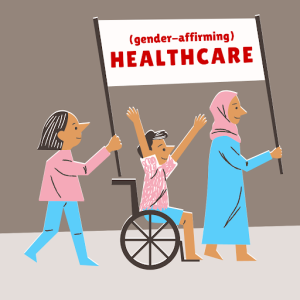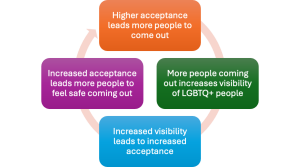(Gender-Affirming) HEALTHCARE
By Vinchenzo Vassalotti, C2ST Intern, Loyola University
As a Sexual and Gender Diversity (SGD) researcher in-training, the foundations of my work acknowledge structural and social inequity – concepts intertwined with public policy. For those who hold diverse gender identities, their access to legal protections and ”gender-affirming care” are at increasing risk due to recent shifts in public policies surrounding this topic. However, the reality is, access to gender-affirming care is not just for sexual and gender-diverse people. Gender-affirming care is healthcare that addresses the needs of a wide array of people, including gender nonconforming and cisgender folks. Limiting access to certain healthcare can have significant, harmful effects for all those who rely upon its assistance.
The following blog is intended to provide an introduction to a component of healthcare commonly known as “gender-affirming care” (GAC), address some harmful myths, and acknowledge the uptick in restrictive legislation.

What is “Gender-Affirming Care”?
For discussing gender identity in this blog, and simplification purposes, there are two key terms: cisgender, and transgender. “Cisgender” refers to when one’s personal gender identity and expression align with their assigned birth sex. For example, someone who was assigned “female” at birth, who feels like and identifies as a woman. Compared to “transgender”, where an individual’s personal gender identity or expression do not correspond with their assigned birth sex. For example, someone who is assigned “female” at birth, but internally feels like and outwardly identifies as a man. There are also “gender nonconforming” individuals who express their gender in unique and personal ways that may or may not align with their assigned birth sex. This could include non-gendered expressions, or presenting their identity in ways that change over time. All these diverse individuals, including identities unmentioned, can benefit from and utilize gender-affirming care. For some, this care can even be lifesaving.
“Gender-affirming” care is a component of healthcare defined by the World Health Organization as, “… any single or combination of a number of social, psychological, behavioral or medical interventions designed to support and affirm an individual’s gender identity.” The key here is “affirm”. All people have distinct relationships with what their gender means to them, and how they might express it; consequently, gender-affirming care looks different for each individual.
Myth #1: Gender-Affirming Care is Only for Trans People
It is often misunderstood that gender-affirming care (GAC) is solely for trans and gender nonconforming individuals. The reality is that cis people utilize GAC too. In an interview by The Hastings Center with Jacob Moses and Theo Schall, health and policy researchers, they discuss that GAC for cis people can be just as essential as GAC for gender-diverse people. For example, the interviewees discuss how medical interventions like breast reconstruction for someone recovered from breast cancer, or penile implants for someone recovered from testicular cancer, can all aid in affirming one’s gender identity.
Moses and Schall presented reconstructive surgeries as examples since, historically, these surgeries weren’t always considered ‘medically necessary.’ This is similar to discussion happening today about gender-diverse people’s access to and usage of GAC. Moreover, cosmetic surgeries such as hair plugs, injectables, or breast augmentations, are also a widely sought form of GAC and can aid in affirming one’s gender presentation. However, it is important to note that not all individuals may seek cosmetic or reconstructive interventions for the purposes of gender affirmation. Not all medical providers view these various interventions as methods of gender affirmation, either. For example, these surgeries may be sought to alleviate discomfort related to perceived flaws, or other reasoning not directly tied to one’s gendered presentation. Rather, it is up to the patient to determine their purpose in seeking these forms of care.
Myth #2: Gender-Affirming Care is All Medical Interventions
The politicization of gender-affirming care has encouraged an incorrect, blanket belief that gender-affirming care interventions are irreversible and destructive manipulations of the body. Rather, GAC includes access to informed mental health services, and various social interventions as well – See more here. These social interventions may include using different pronouns, trying different haircuts or clothing styles, and exploring other social and behavioral expressions of their gender.
Working with an informed and equipped medical professional provides beneficial guidance to gender-diverse people. Medical professionals provide invaluable information as to social changes one can initiate, but can also aid patients in navigating discussions with close ones and locating community resources. Most importantly, they can provide professional counseling as to how and when one may seek medical intervention, if desired. Although it is true that some interventions within GAC are irreversible, they are only conducted under the guidance of a trusted medical professional on those who are very well informed before any procedure takes place. Access to informed health professionals is essential. This knowledgeable, unbiased advice encourages individuals to be aware of all their potential options. Gender-affirming care is much, much more than medical interventions.
Myth #3: Gender-Affirming Care is a Trend
Identifying as gender-diverse is not a novel phenomenon. Moreover, having a gender-diverse identity is not a trend for the youth. Gender diverse people have been recorded in cultures as early as 5000 B.C. Trans youth have been identified in Western culture as early as the 1930s, according to medical historian and author Jules Gill-Peterson. As culture increases in its openness toward diverse identities, individuals holding these identities may feel more empowered to ‘come out’. The Human Rights Campaign discusses this cycle, that I have restructured into a visual:

As our society becomes more accepting of various marginalized identities, more people feel encouraged to express their identity. In turn, the more individuals that “come out”, the more accepting our culture becomes. As culture responds to and accepts diverse identities, the cycle encourages honest expression from those who may have withheld their identity before.
It is necessary to acknowledge that holding a gender-diverse identity is not a choice, but an identity that reflects one’s internal sense of self. Seeking GAC, for some, is progress towards aligning one’s sense of gender, to their outward presentation. In this sense, access to GAC is a lifesaving form of care. Some trans and gender nonconforming individuals may experience what is known as “gender dysphoria”. Gender dysphoria, as defined by the American Psychological Association, is a form of mental distress that individuals experience when their assigned gender doesn’t align with their gendered identity. This distress is a mechanism behind the prevalence of anxiety, depression, and suicidal ideation within the gender-diverse community.
Why You Should Stay Informed:
Misrepresenting different forms of healthcare encourages harmful misunderstandings of what access to and usage of this care realistically looks like. I present this blog in acknowledgment of the uptick in legislation attempting to restrict and dismantle (gender-affirming) healthcare. Gender-affirming care, ultimately, is a conversation between patients, families, and medical professionals encouraging informed decisions on how to navigate and strengthen one’s gender identity and expression.
As discussed in the myths above, GAC is more than trendy, irreversible medical intervention for trans people. Rather, it is a diverse and multifaceted form of healthcare that addresses social, psychological, and medical needs for all people, of all ages, and all gender identities. Most importantly, it is a life-saving component of healthcare.
References:
- Frequently Asked Questions about Transgender People | A4TE
- Gender-Affirming Care for Cisgender People: Q&A with Theodore Schall and Jacob Moses – The Hastings Center
- Gender‐Affirming Care for Cisgender People – Schall – 2023 – Hastings Center Report – Wiley Online Library
- Transgender youth: ‘Forced outing’ bills make schools unsafe | AP News
- What is gender-affirming care? Your questions answered | AAMC
- Gender-Affirming Care and Young People
- Seven Things About Transgender People That You Didn’t Know
- 3 The history and geography of human handedness
- Map: Attacks on Gender Affirming Care by State – Human Rights Campaign
- Get the Facts on Gender-Affirming Care – Human Rights Campaign